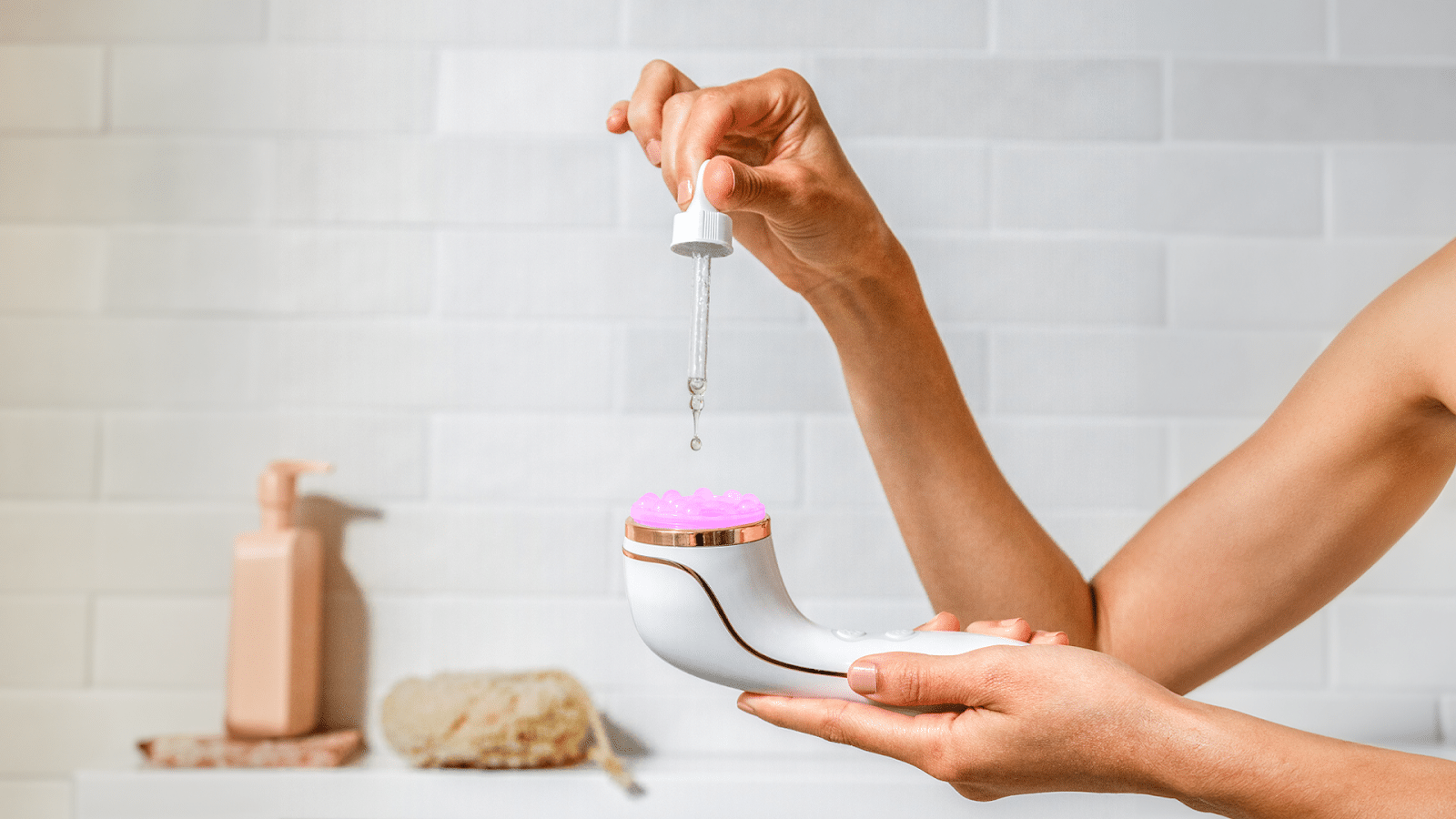Light therapy, combined with powerhouse skincare serum ingredients, can amplify your results and help you achieve healthy, radiant skin. But what not everyone knows is that some serums can be applied before light therapy. In fact, some active ingredients like Vitamin C and niacinamide can have their effects amplified up to 12 times when combined with LED light therapy. Think of it like giving your skin an extra shot of brilliance—and who wouldn’t be all in on that?
Common skin goals and how to achieve them
Whether you’re targeting acne, brightening your complexion, or trying to smooth wrinkles and fine lines, the right combination of ingredients and powerful LED light can make all the difference. Read more for a simple breakdown of how to pair popular active ingredients in skincare serums and light therapy to finally achieve your skin goals.
Start with a clean slate
Cleanse according to your skin type
No matter what skin concerns you’re trying to tackle, the first step of any good skincare routine is making sure your skin is free of impurities like dirt, oil, and dead skin cells. How you cleanse is up to you and your unique skin type. Dull and dry skin benefits from more exfoliation, and sensitive skin might need a gentler gel cleanser. Cleansing not only removes impurities but also allows your skincare ingredients and light therapy to penetrate deep below the surface and get to work.
Brighten Your Complexion

Combo: Vitamin C + Red Light Therapy
Unsurprisingly, sunny citrus-based Vitamin C is a go-to ingredient to dial up the brightness. Known for its antioxidant properties, Vitamin C helps fade dark spots, neutralizes free radicals, and increases cell turnover to improve dullness and dryness. Use this serum sparingly and allow it to fully absorb into the skin before red light therapy treatment to maximize the brightness benefits. Be sure to store your vitamin C serum away from sunlight to prevent degradation.
Banish Acne

Combo: Salicylic Acid + Blue Light Therapy
If you’re suffering from acne flare-ups and your light therapy device offers both blue and red light therapy, you’re in luck. Pair bacteria-busting blue light with a serum containing a beta-hydroxy acid (BHA) like salicylic acid for clearer, blemish-free skin. BHA-containing products work by penetrating deep into clogged pores to eliminate bacteria and reduce inflammation, while also breaking down the bonds that keep dead skin cells stuck on the surface. Apply your serum first, giving special attention to acne-prone areas, and let it absorb before treating with blue light therapy.
Boost Collagen Production
Combo: Glycolic Acid + Red Light Therapy + Retinoid
Dealing with sagging, crepey skin? As we age, our cells naturally slow the production of collagen, the protein in our skin that provides the plumpness we tend to take for granted in our twenties. Applying a serum containing glycolic acid (a type of alpha-hydroxy acid) before light therapy exfoliates the skin and makes it more receptive to the collagen-boosting effects of red light therapy treatment. Follow up with a retinoid (always apply any type of retinoid after light therapy) ten minutes later to further enhance collagen production and promote smoother, firmer skin.
Reverse Signs of Aging

Combo: Hyaluronic Acid + Red Light Therapy + Retinoid
Plagued by fine lines, crow’s feet, or the dreaded elevens (the two pesky frown lines on the lower forehead, between the eyes)? Hyaluronic acid, which occurs naturally in the body to reduce friction in our joints, eyes, and skin, enhances light absorption and promotes water retention (we often think of retaining water as not great for our body, but it’s a must for supple skin). Applied before red light therapy, hyaluronic acid increases light penetration to smooth fine lines and promote collagen production to fill in deeper wrinkles. As always, apply your favorite retinoid ten minutes after light therapy to further the anti-aging power.
Reduce Redness and Inflammation
Niacinamide + Red Light Therapy
If your skin tends to get red and irritated, niacinamide (also known as Vitamin B3), is a soothing ingredient that refines skin tone, strengthens the skin barrier, and reduces inflammation. Depending upon your skin’s tolerance, you may apply a serum containing niacinamide before or after light therapy. If redness increases, wait longer between serum application and treatment or apply at least ten minutes after a light therapy session.
Fade Acne Scars
Lactic Acid + Combo Light Therapy + Retinoid
For deep scarring from acne, use a device that offers both blue and red light therapy. Blue light destroys acne-causing bacteria deep within the pores, and red light therapy promotes healing and reduces the appearance of scars. Lactic acid (a chemical exfoliant and a type of alpha-hydroxy acid) is often combined with red light therapy in spa treatments to prime the skin for maximum penetration of LED light, encourage cell turnover, and improve skin tone and texture. To avoid skin irritation, wait ten minutes after light therapy sessions to apply a retinoid.
Moisturize and Protect Last

Hydrate skin to stay healthy
The last step of any skincare routine should be to lock in hydration. Apply a moisturizer directly chosen for your skin type (dry, sensitive, oily, etc) to hydrate skin and restore balance. And don’t forget the most important step: SPF. Any time you use active ingredients such as acids or retinoids, your skin can become more sensitive to sunlight. Daily sunscreen application is not optional—your skin will thank you in twenty years.
As with any skincare routine, listen to your body. Light therapy is a powerful tool, but everyone’s skin is different and it’s important to introduce new products and treatments gradually. Discontinue use if irritation develops and consult a dermatologist for medical advice.
